This page is no longer current and is provided for archival and research purposes.
Appendix III: Age-friendly community and quality of life instrument studies
The charts that follow present a summary of each existing instrument that was designed to measure either QoL (purple charts) or a community’s age-friendliness (teal charts). For each dimension, the chart will tell you the number of questions that particular instrument contains (dark bar), the average number of questions in an instrument and the maximum number of questions in an instrument (light bar). Please note that averages and maximums were calculated separately for QoL and AFC instrument groups. Along with each chart you will find a description of the instrument that summarizes its strengths and weaknesses, as well as details about its creation and use.
AQoL Dimension Robustness

Description: The AQoL 8D instrument is part of a larger suite of instruments developed to assess health-related QoL for economic evaluation studies, although their use has broadened considerably beyond this initial purpose. This instrument set is based on the WHO’s definition of QoL and uses a multi-dimension structure to measure aspects of QoL that are important from the perspective of both individuals and policymakers.The AQoL instrument was developed by a collaborative of government agencies and universities led by researchers from the Centre for Health Economics at Monash University in Australia.
Target Group: Although not developed specifically for use with older adults, questions in the AQoL instrument are well suited for use in a community-wide AFC assessment and the instrument has been used in the context of research with older adults.
Dimension Robustness: This instrument covers six of the eight dimensions used in this guide and well over half of its questions focus on the Community Support and Health Services dimension.
Instrument Cost And Availability: Questions from the instrument have been included in the online database associated with this tool kit and a copy of the complete instrument, along with instructions on analyzing results for the complete instrument, can be downloaded free of charge at www.aqol.com.auIaqolquestionnaires.html.
GHQ Dimension Robustness
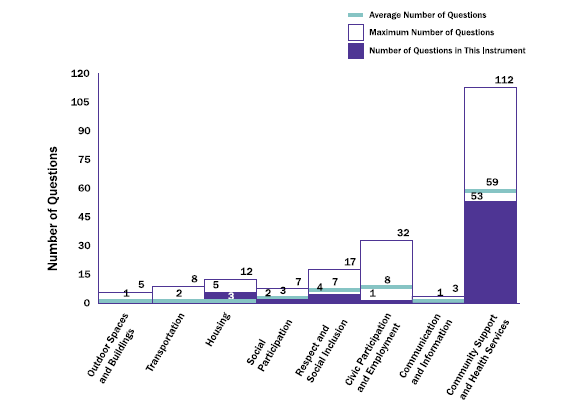
Description: The GHQ-60 is the longest version of a popular screening instrument known as the General Health Questionnaire, developed by Dr. David Goldberg to identify mental health conditions within a community or clinical setting.
Target Group: The GHQ is designed for use as a self-administered questionnaire and is therefore adaptable for use in a community-wide AFC survey to measure health-related QoL, although it was not designed specifically for use with older persons.
Dimension Robustness: The GHQ focuses almost entirely on the Community Support and Health Services dimension, with a small number of questions addressing issues of Social Participation and Respect and Social Inclusion.
Instrument Cost And Availability: Due to the proprietary nature of the instrument, questions from the GHQ have not been included in the online database associated with this tool kit. You can get a package of 25 instruments at a cost of £56.99. You can buy the associated user guide for £82.50. For more information go to shop.gl-assessment.co.uk/home.php?cat=416.
LEIPAD Dimension Robustness
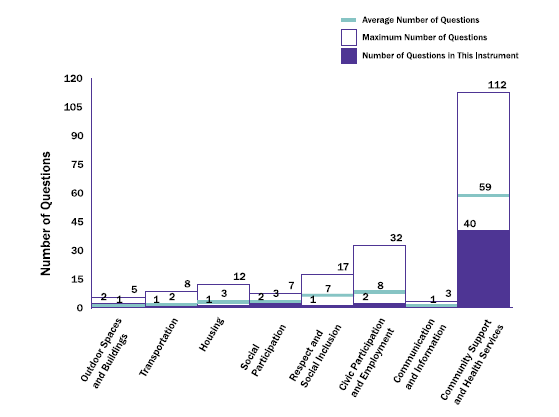
Description: With the support of the European office of the WHO, researchers from universities in Leiden,Holland; Padua, Italy; and Helsinki, Finland, collaborated to create a general QoL assessment tool with a comprehensive focus and strong cross-cultural validity, which they specifically designed for use with older adults. They initially developed the resulting LEIPAD instrument to combine questions from existing instruments and questions they selected based on findings from the body of literature on aging, but refined it repeatedly to produce a final self-administered survey.
Target Group: Because of its intentional focus on older adults’ QoL and the structure of its questions, the LEIPAD instrument is very well suited to include in a community-wide AFC survey.
Dimension Robustness: The LEIPAD instrument focuses heavily on the Community Support and Health Services dimension but contains a few questions covering most dimensions.
Instrument Cost And Availability: Questions from the instrument have been included in the online database associated with this tool kit and a copy of the complete instrument is available to download from the Taylor & Francis group at the cost of $37 US, available at www.tandfonline.com/doi/abs/10.1080/08964289809596377?journalCode=vbmd20.
MOS Dimension Robustness
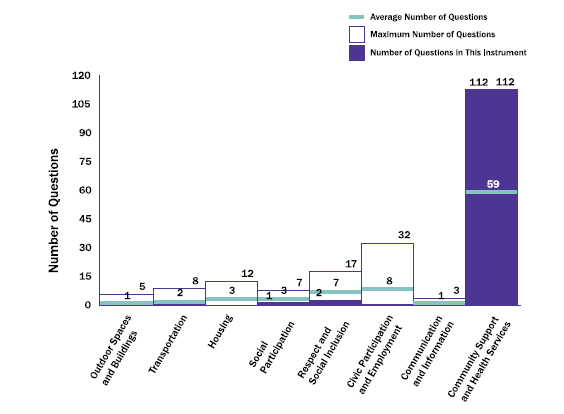
Description: The MOS core survey instrument was created under the auspices of the RAND Corporation, a not-for-profit research and analysis institution dedicated to advancing knowledge in a host of fields that include health, education and the environment. The MOS is the complete version of the popular SF-36 instrument and was developed to measure HRQoL to supplement biomedical evaluations of health interventions. Developing the instrument took place as part of a multi-year observational study that sought to assess the effect of physician practice styles on HRQoL among a cross-section of 22,399 patients and a panel of 2,471 patients.
Target Group: The MOS is a self-administered questionnaire containing generic questions focused on individual functioning and well-being, and although not designed specifically for older adults, it has been used in assessment research with this subject group.
Dimension Robustness: Of the QoL instruments in this guide, the MOS has the strongest focus in the Community Support and Health Services dimension.
Instrument Cost And Availability: Questions from the instrument have been included in the online database associated with this tool kit and a copy of the complete instrument and its user guide can be downloaded free of charge, with restrictions on its use, at www.rand.org/health/surveys_tools/mos.html.
QLESQ Dimension Robustness

Description: In 1993, as lead author of a peer-reviewed article in the Psychopharmacology Bulletin, Dr. Jean Endicott of Columbia University designed an instrument for the clinical assessment of individuals’ health-related QoL by evaluating their enjoyment and satisfaction with daily living. Since that time, the Quality of Life Enjoyment and Satisfaction Questionnaire (QLESQ) has been used in a range of studies addressing health-related QoL as the outcome of specific interventions, with mental health research being a particularly common application.
Target Group: Due to its design as a self-administered survey, questions from the QLESQ instrument are well suited for use in a community-wide AFC survey, although the instrument was not created specifically for use with older adults.
Dimension Robustness: Of the QoL instruments in this guide, QLESQ has the strongest focus on the Housing and Civic Participation and Employment dimensions. Along with the QoLQ instrument, it also contains the highest number of questions about Social Participation.
Instrument Cost And Availability: Questions from the instrument have been included in the online database associated with this tool kit and a copy of the complete instrument can be downloaded free of charge at http://www.opapc.com/uploads/documents/Q-LES-Q.pdf
QoLQ Dimension Robustness
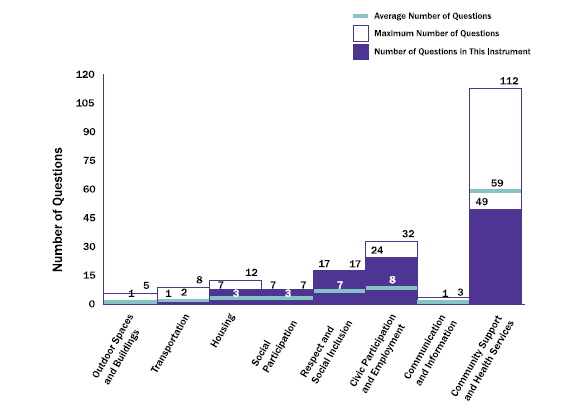
Description: Dr. Robert Schalock and Dr. Kenneth Keith developed the Quality of Life Questionnaire (QoLQ) as a clinical assessment tool for evaluating QoL among persons with varying levels of cognitive impairment.
The instrument has been used extensively in this context, but its application has also broadened to include non-clinical evaluations of persons without a mental health condition.
Target Group: The instrument was designed to be completed as a participant self-assessment or to be completed by a caregiver with extensive knowledge of a participant’s daily life activities.
Dimension Robustness: Along with the QLEQLESQSQ instrument, the QoLQ tool contains the highest number of questions about Social Participation. It also has the strongest focus on Respect and Social Inclusion.
Instrument Cost And Availability: Due to the proprietary nature of the instrument, questions from the QoLQ have not been included in the online database associated with this tool kit. A package of 25 instruments and a copy of the user guide can be purchased for $110 USD. For more information go to www.idspublishing.com/resources/QOL.pdf
QWB-SA Dimension Robustness
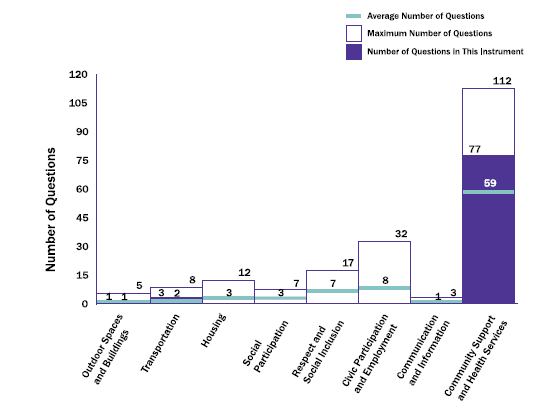
Description: The Quality of Well Being Self-Assessment (QWB-SA) was developed in the mid-1990s by researchers at the University of California San Diego as an efficient alternative to the original Quality of Well-Being instrument. The purpose of the new instrument was to provide an alternative means of rapid health status assessment that could be used in the calculation of Quality of Adjusted Life Years, as no existing instrument at the time was suitable for use in the calculation of this metric used in standardized comparisons of health interventions.
Target Group: The QWB-SA was designed as a health-related QoL instrument that assesses an individual’s functioning and health symptoms, and, although it was not created specifically for use with older adults, its suitability with this population has been verified.
Dimension Robustness: The QWB-SA contains questions covering only three of the eight dimensions used in this guide and it is strongest in the area of Community Support and Health Services.
Instrument Cost And Availability: Due to the proprietary nature of the instrument, questions from the QWB-SA have not been included in the online database associated with this tool kit. A copy of the instrument can be downloaded at www.healthmeasurement.org/Measures.html. However, modification, duplication or distribution is prohibited without permission from the authors.
WHOQOL Dimension Robustness
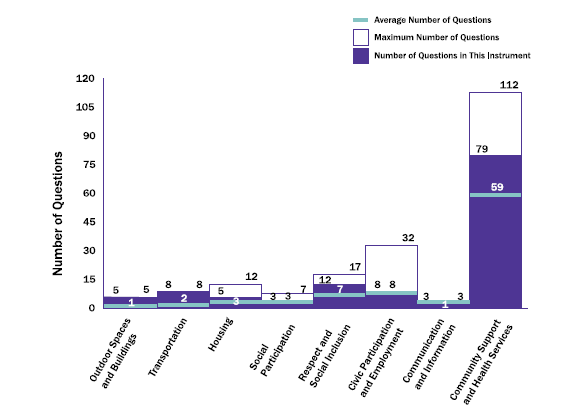
Descirption: The WHOQOL 100-0LD was adapted from the original WHOQOL-1 00, which was revised and supplemented with a module to address the needs of an older population. Similar to its predecessor, the WHOQOL1 00-0LD was developed following the WHO ’s bottom-up participatory process, including: a peer review of the original instrument; cross-cultural focus groups with older adults, caregivers and service providers; pilot testing and refinement with 7,401 participants in 22 international centres; and field testing with 5,566 participants in 20 international centres.
Target Group: Except for the LEIPAD instrument, the WHO QOL 100- OLD is the only QoL instrument included in this tool kit specifically intended for use with older adults.
Dimension Robustness: The WHOQOL100- OLD has the widest dimension coverage of the QoL instruments in this guide. It also has the strongest focus of any instrument in the areas of Outdoor Spaces and Buildings,
Transportation, and Communication and Information.
Instrument Cost And Availability: Questions from the original instrument and the supplementary module have been included in the online database associated with this tool kit, and a copy of the complete WHOQOL 100 instrument and its user guide can be downloaded free of charge at www.who.int/mental_health/publications/whoqol/en/index.html.
AARP Dimension Robustness
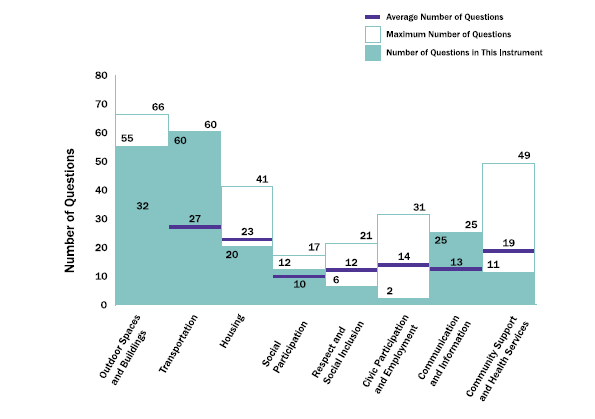
Description: A project team of planners from the State of Arizona and Arizona State University prepared the Livable Communities: An Evaluation Guide for the AARP Public Policy Institute. The most recent release of the guide, in 2005, is an update of an original publication released in 2000 by Patricia Pollack of Cornell University. This update incorporated older adults’ conceptions of a livable city through an online survey and focus groups that were carried out in 13 U.S. cities.
Target Group: Although many of its questions are easily adapted to a community-wide survey, the AARP guide is designed for use by a small group of stakeholders working in tandem to complete the instrument.
In addition to the actual assessment, the guide contains a section outlining why an assessment should be carried out; who should be involved; what materials are necessary; and what steps should be taken once the data are collected.
Dimension Robustness: The AARP assessment contains questions primarily about the community environment, with slightly more than half of these questions exploring aspects of the physical environment.
Of the AFC instruments in this guide, the AARP tool has the strongest focus on transportation and also has an above-average number of questions in several other AFC dimensions. One notable exception to this is the Civic Participation and Employment dimension, which has only two questions.
Instrument Cost And Availability: Questions from Livable Communities: An Evaluation Guide have been included in the online database associated with this tool kit and a copy of the guide can be download free of charge at www.aarp.org/home-garden/livable-communities/info-2005/livable_communities__an_evaluation_guide.html.
AdvantAge Dimension Robustness

Description: The AdvantAge Initiative is a community-building effort directed by a small team of researchers from the Center for Home Care Policy and Research, which the Visiting Nurse Service of New York established in 1993. The AdvantAge survey follows a novel framework for age-friendly communities that emerged during a qualitative research effort involving 14 focus groups in four U.S. cities. The survey research firm Westat piloted the initial instrument as a community-wide telephone survey with over 5,100 participants in 10 U.S. cities, and work is currently underway to convert the telephone instrument into an online survey.
Target Group: The AdvantAge Initiative instrument is specifically designed to survey an older adult population.
Dimension Robustness: The AdvantAge survey is the only AFC instrument included in this guide that has a higher proportion of questions about persons than about environments, and more of the environment questions focus on social elements than physical. Compared to the other AFC instruments included in this guide, the AdvantAge survey has the strongest focus on Community Support and Health Services and Housing. Due to its focus on social elements, however, it is particularly weak on the Outdoor Spaces and Buildings dimension.
Instrument Cost And Availability: Due to the proprietary nature of the AdvantAge survey, the questions from the instrument could not be included in the online database. Information about cost and availability can be obtained by contacting the AdvantAge Initiative: www.vnsny.org/advantage/index.html.
CASOA Dimension Robustness
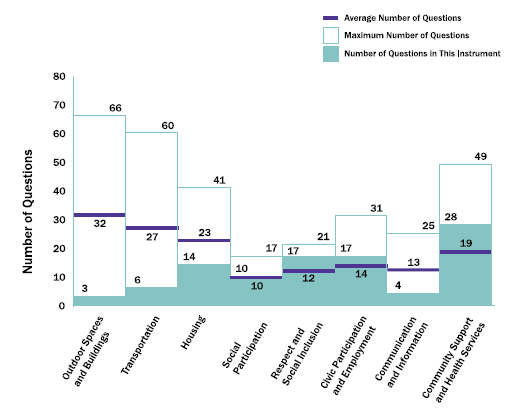
Description: The National Research Center in Boulder, Colorado, designed the Community Assessment
Survey for Older Adults (CASOA) to provide practical, baseline information to guide planning, program development and advocacy efforts at the local level. Developing the instrument was based around common needs and community supports that are relevant to agefriendliness, as determined through the National Research Center’s experience with providing programs for older adults and the body of literature on aging.
Target Group: The CASOA was designed as a mail-out survey targeting the older adult population.
Dimension Robustness: The CASOA survey contains a strong balance between person-centred and environment-centred questions, with significantly more questions about the social environment than the physical environment. The dimensions of Social Participation, Respect and Social Inclusion, Civic Participation and Employment, and Community Support and Health Services all contain an above-average number of questions.
Instrument Cost And Availability: Questions from the instrument have been included in the online database associated with this tool kit and a copy of the complete instrument can be found as an appendix to the 2010 Report for Larimer County, which is available for download free of charge at www.larimer.org/seniors/lcoa.htm
Cleveland Dimension Robustness
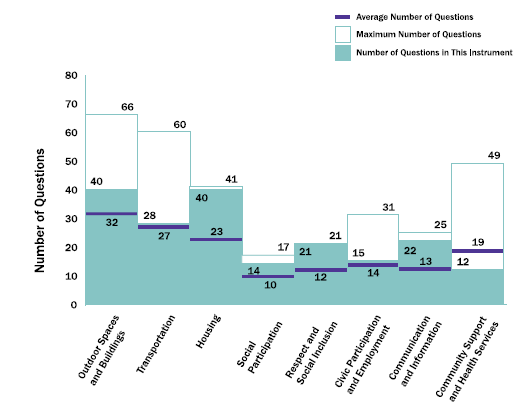
Description: In 2004, the Cuyahoga County Planning Commission and the Cleveland Foundation released the Guide to Elder-Friendly Community Building as part of the foundation’s Successful Aging Initiative. The guide has been ‘designed to occur within normal city, village or township planning and budgetary processes,’ although it contains many resources that any stakeholder interested in AFC would find useful. Besides the assessment questions, the guide discusses the AFC planning process and provides worksheets to help a community develop an AFC profile and map out their five-year AFC capital plan.
Target Group: Many of the questions are structured to be completed by an individual or project team, but can easily be reworded for a community-wide survey of older adults, caregivers and service providers.
Dimension Robustness: The Cleveland needs assessment includes more questions about the community environment than about persons living in the community, and more of these address social aspects of the community than physical aspects. The instrument has the strongest focus on Respect and Social Inclusion of any included in this guide and has a very strong focus on housing as well. Except for Community Support and Health Services, all other dimensions contain an above-average number of questions.
Instrument Cost And Availability: Questions from the instrument have been included in the online database associated with this tool kit and a copy of the complete instrument, contained in the guide, can be downloaded free of charge at https://www.michigan.gov/documents/Guide_to_EFC_Building1_156733_7.doc.pdf
Hamilton Dimension Robustness
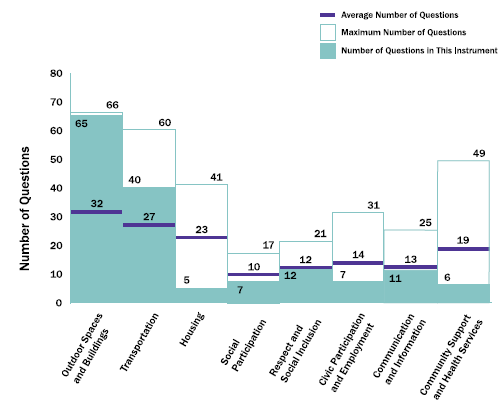
Description: The Hamilton Council on Aging and the Gilbrea Centre for Studies in Aging at McMaster University developed the Age-Friendly Hamilton Questionnaire. The questionnaire asks for older adults’ opinions on the age-friendliness of their city by seeking their agreement (using a Likert scale ranging from ‘strongly disagree’ [1] to ‘strongly agree’ [5]) with a set of statements about the age-friendliness of the eight dimensions proposed by the WHO. This questionnaire is based on the Age-Friendly Cities checklist.
Target Group: The Age-Friendly Hamilton Questionnaire has been designed as a mail-out survey for older adults, but it could be adapted to other formats, such as an online survey or a personal interview.
Dimension Robustness: The Hamilton instrument has a stronger focus on Outdoor Spaces and Buildings than almost all other instruments in this guide, and contains an above-average number of Transportation questions.
Instrument Cost And Availability: The questions from this survey have been included in the online database associated with this tool kit and a full copy of the instrument can be obtained from the Hamilton Council on Aging upon request: www.coahamilton.ca.
Michigan Dimension Robustness

Description: A collaboration of several state agencies produced the Michigan Community for a Lifetime:
Elder Friendly Community Assessment as part of the Community for a Lifetime recognition program. The Michigan assessment was developed from the content of various existing instruments and the body of research findings in the areas of elder-friendly and livable communities.
Target Group: The Michigan assessment was designed for a small project team to use, although many of the questions can be easily adapted for a community-wide survey of older adults, caregivers and service providers.
Dimension Robustness: The Michigan assessment focuses heavily on questions about the community environment, with more of these questions addressing social elements than physical elements of the community. It has the strongest focus on Outdoor Spaces and Buildings of any instrument and, except for
Civic Participation and Employment, all dimensions contain at least an average number of questions in comparison to other AFC instruments.
Instrument Cost And Availability: Questions from the instrument have been included in the online database associated with this tool kit and a copy of the complete instrument can be downloaded free of charge at http://www.michigan.gov/documents/miseniors/4-Michigan_CFL_Assessment_199109_7.pdf
WHO AFC Dimension Robustness

Description: Discussions during the 2005 World Congress of Gerontology and Geriatrics in Rio de Janeiro, Brazil, were the first motivation that ultimately led to the creation of Global Age-friendly Cities: A Guide. With support from its international partners, the WHO took the mandate from this meeting and conducted 158 focus groups with 1,485 participants in 33 international cities, exploring the features that were important to age-friendliness from the perspective of older adults and using the results of this research as the basis for its guide. The WHO AFC guide is based on eight age-friendly themes, and for each of these themes presents a discussion of its importance along with a checklist of relevant age-friendly features.
Target Group: The WHO checklists are designed to complement a focus group–based data collection process entitled the Vancouver Protocol. Most questions are well suited to a community-wide survey of older adults, caregivers and service providers.
Dimension Robustness: The WHO AFC guide contains the highest proportion of environment-centred questions of any AFC instrument in this guide, and just over half of these questions focus on the community’s social environment. It is also the strongest instrument in the dimensions of Civic Participation and Employment, and contains at least the average number of questions in all but two of the remaining dimensions.
Instrument Cost And Availability: Questions from the instrument have been included in the online database associated with this tool kit and a copy of the complete instrument can be downloaded free of charge at www.who.int/ageing/age_friendly_cities_guide/en/.
Rural AFC Dimension Robustness
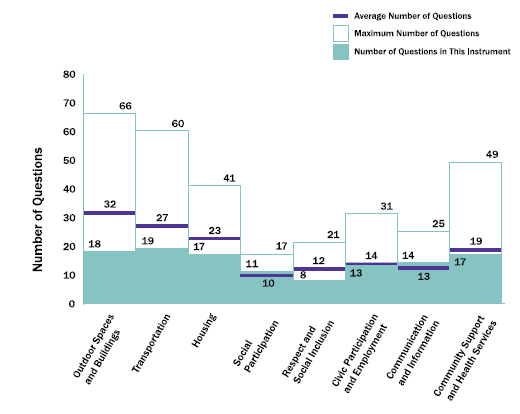
Description: In 2006, the Federal/Provincial/Territorial Ministers Responsible for Seniors officially recognized the need to extend the work of the WHO’s AFC initiative to include smaller, more isolated communities, whose contexts differ considerably from larger municipalities. Using the WHO’s Vancouver Protocol as a framework, a working group comprised of multiple government agencies and academic researchers produced Age-Friendly Rural and Remote Communities: A Guide, which was based on the shared experiences of 107 older adults and caregivers who were part of focus groups in 10 diverse communities across Canada.
Target Group: Questions in the Rural AFC guide are found as part of a self-assessment checklist, but like its WHO counterpart, most of these are well suited to include in a community-wide survey of older adults, caregivers and service providers.
Dimension Robustness: The Rural AFC guide contains a higher proportion of environment-centred questions than other AFC instruments discussed in this guide, which are mainly focused on the physical environment. The Rural AFC guide is strongest in the Social Participation dimension, and contains multiple questions covering all of the remaining dimensions.
Instrument Cost And Availability: Questions from the instrument have been included in the online database associated with this tool kit and a copy of the complete instrument can be downloaded free of charge at www.phac-aspc.gc.ca/seniors-aines/publications/public/healthy-sante/age_friendly_rural/index-eng.php
Vital Communities Dimension Robustness
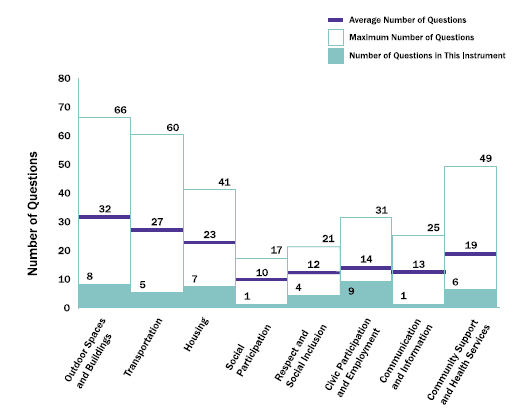
Description: The Vital Aging Network (VAN) is a community collaborative based out of St. Paul, Minnesota, communities and their own lives. In 2004, during its summit event, the VAN started its Vital Communities Toolkit, and as part of that tool kit they created the Vital Communities assessment, which has been designed as a community-wide survey.
Target Group: The Vital Communities Toolkit is designed for use with older adults and caregivers.
Dimension Robustness: The Vital Communities Toolkit is heavily focused on questions about the community environment, and slightly more than half of these questions address elements of the social environment as opposed to the physical environment. The Vital Communities assessment is considerably shorter in length than other AFC instruments in this guide; however, it does contain questions about each of the AFC dimensions.
Instrument Cost And Availability: Questions from the instrument have been included in the online database associated with this tool kit and a copy of the complete instrument can be downloaded free of charge at www.vital-aging-network.org/Vitai_Communities_Toolkit/Tools/72/Community_Assessments_Surveys.html#vital_assessment.